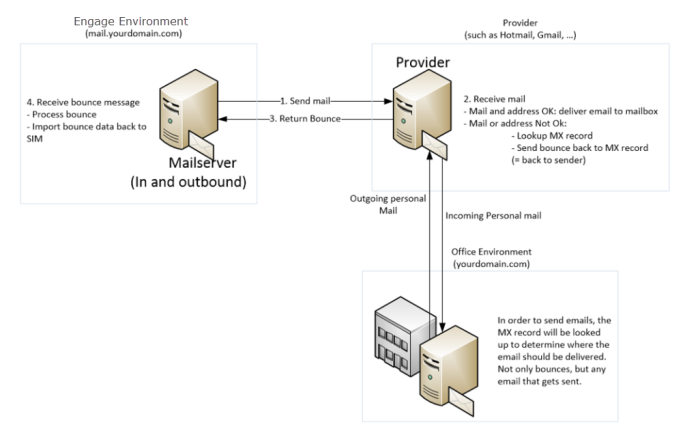Introduction
Customers often have questions about why they need to have a dedicated domain for their Marigold environment. Dedicated in this context means that the domain should only be used within the Marigold environment. It should not be used on other platforms. This document will try to explain the reasons for that.
Bounce handling
When you activate an e-mail campaign in Marigold it’s inevitable that some of the e-mail addresses you’re sending to will be unreachable (they might be inactive, their mailbox might be full, ...). In order to notify you, providers that receive e-mails for such addresses will send you a notification. This is essentially an email which contains the failed address and the reason why your mail cannot be delivered to it. We call this message a bounce message.
As you can see in the overview above, the provider looks up the MX record of the sender’s domain. An MX record can be seen as a property of the sending domain, which indicates where the bounces should be sent back to. You could compare it to the address of a house.
For campaigns made in Marigold it’s important that these bounces are sent back to the Marigold environment. This is why the MX record of the sending domain should point back to the Marigold server. Marigold will process these bounces and insert the data back into your database.
The process of looking up MX records is also used for the day to day sending of e-mails. If someone with a Hotmail account sends an e-mail to yourdomain.com, Hotmail will look up the mx record of yourdomain.com and deliver the e-mail there. If you wanted to use yourdomain.com in Marigold as well, you would have to change that MX record so it points to the Marigold environment. As a consequence, e-mails sent to yourdomain.com won’t reach your office anymore. Instead, they will all be sent to the Marigold environment where they will be processed like bounces.
To resolve this issue we ask you to create a dedicated subdomain, for instance mail.yourdomain.com. You can change the MX record for this domain without affecting the MX record for yourdomain.com. As a result, bounce messages for mail.yourdomain.com will arrive at the Marigold environment and regular e-mails sent to yourdomain.com will arrive at your office.
Webpages
Webpages work in a similar way as the mail domain. When you browse to http://yourdomain.com, the IP for this domain is looked up and the webpage is loaded from that IP. If you would change that IP to point to the Marigold server, http://yourdomain.com will no longer point to your website. Therefore, we ask that you create a subdomain such as http://customer.yourdomain.com, which is the CNAME(1) to the instance address of the Marigold server (eg. customer.slgnt.eu). That way, http://yourdomain.com will load your main website, while http://customer.yourdomain.com will load the Marigold web pages.
(1) Note: A Canonical Name or CNAME record is a type of DNS record that maps an alias name to a true or canonical domain name. CNAME records are typically used to map a subdomain to the domain hosting that subdomain's content.
Domain reputation
When sending e-mail campaigns your mail domain and IP get a reputation. This means providers are getting to know you and the traffic you send and they will give it a reputation which indicates what they think of you. If you have a good reputation your e-mails will arrive in the inbox of your clients and the results for your campaigns will be good. If you have a bad reputation your e-mails are most likely to arrive in the spam folder or will be blocked by the provider, resulting in bad delivery results for your campaigns.
All traffic sent with a certain domain has influence on that domain. That means that if you use the Marigold domain on other platforms as well, these platforms might have a negative influence on your Marigold campaigns or vice versa. Bulk mailings always have some kind of risk attached to them, which means that if anything bad happens to your bulk mailings, it might also happen to your corporate mailings. In worst case scenarios, this might mean your corporate mail gets blocked as well. If you use different subdomains for different platforms, the chances of them influencing each other are much smaller.
Sharing the domain across multiple platforms will also make it very difficult to mitigate issues should they happen. Our deliverability consultants won’t have a clear view of all traffic that is sent using this domain, which makes pinpointing issues nearly impossible.


